About Antwerp and the Red Star Line - 1904
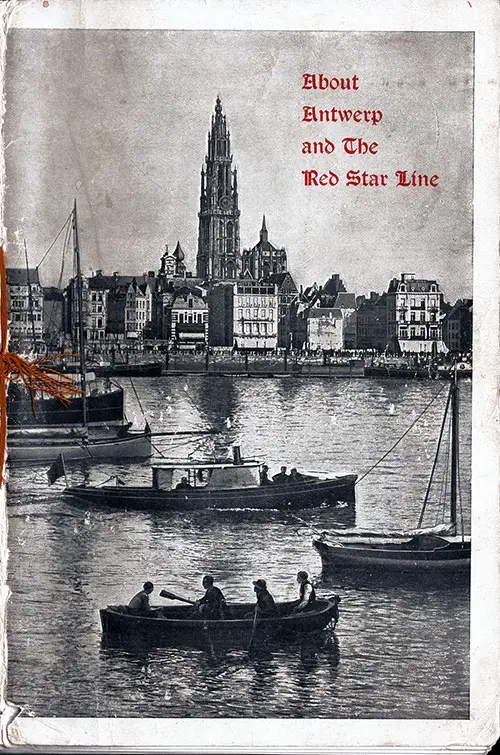
Front Cover, Brochure About Antwerp and the Red Star Line © 1904. | GGA Image ID # 11d9645deb
A 50-page brochure from the Red Star Line provides extensive information on Antwerp's harbor, the city's history, and the Red Star Line transatlantic fleet. Many photographs help to illustrate this rare booklet from 1904.
NEW AND OLD ANTWERP, THE APPROACH...
ABOARD the great liner Zeeland, we are entering the Scheldt, "greyest of grey rivers," a broad estuary held back by long lines of dikes from inundating a land that in summer is variegated with harvests of wheat and market vegetables.

A View of Antwerp Harbor. | GGA Image ID # 11d97ef69
As we approach from the North Sea, the shores at first are far apart and but faintly visible, but ascending, we have reached within an hour the narrower stretch of the river, where on either side the American traveler looks out, perhaps for the first time, upon the Netherlands.
And, truth to say, one is very apt to feel as if one's childhood dreams had suddenly come true, for the landscape is nothing if not "Noah's-Arky," with its groups of trees that seem flattened out against the horizon like the corkscrew trees of the nursery; its distant herds of stageland cattle, and its antediluvian river craft.
From the upper deck, one gets fascinating glimpses here and there of red-roofed farmhouses, girt about with gardens and orchards; distant thickets of birch and oak, and plantations of Scotch fir—Christmas trees for all the world.
Then, too, there are the little towns, sometimes so well hidden behind the dikes that merely the roofs of the buildings and the many church steeples peep up.
Beside each one of these hamlets, there appears an elaborate graveyard with tombs situated above ground—an indication of the excessive moisture of the soil; and almost every community has its characteristic old windmill with four sails lazily revolving in the breeze.
At every turn of the broad river, we pass clusters of big brown barges with red sails, making their sluggish way to or from Antwerp. It is all soft, low-toned, picturesque, quite unlike what we have seen in America, not even excepting the pastoral scenery along the Detroit River.
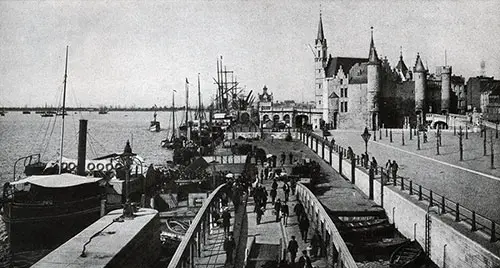
The Steen Landing at Antwerp. | GGA Image ID # 11d99d3c0c
And the charm of it in American eyes lies doubtless just in its differences. If the Scheldt was like the Mississippi or the Hudson, we might better have stayed at home. It is the old-worldliness that attracts.
But for the big steel steamships which now and then one passes—a reminder of the world of today—one might almost fancy one's self entering the Netherlands of the time of William the Silent.
At last, there arises over the plains the distant skyline of the city of Antwerp: first its lofty Cathedral spire, then other towers, then the serrated roofs of the city houses.
Finally, at the last great bend of the river, we make a turn, and, more suddenly than we expect, find ourselves face to face with the two-mile stretch of hustling quays which are evidence of the modem prosperity of the ancient city.
Then, as the steamship swings to her dock, there appear on the right hand, seen through the openings between enormous warehouses, revelations of architectural beauty; while on the other side we still view the endless green plains dotted with farms and villages, upon which we have been looking down all the way up the Scheldt.
Naturally, it is the high-peaked roofs and dormer windows, the generally different appearance of the architecture that takes most of our attention—mainly if this is our first visit to a European city.
The very wharves are alive with a strange life: dock porters in odd blouses, sellers of queer liquids, skippers and crews of Dutch canal boats, sailors of every gradation of color who speak such diverse languages that one instinctively looks up the street to see if the Tower of Babel is not in sight.
The porters wear a great cloth which covers their heads and shoulders, and they carry enormous burdens, many of the men taking upon their shoulders bales of fabric, wood pulp or bundled shrubs that may weigh upwards of 400 pounds.
Amid such moving spectacles, the American realizes that he is face to face with the sights and customs of a foreign land.
Such is the approach to Antwerp, and fortunate the man or woman who gets his first impressions of the Old World from the ancient Flemish city.
More significant in the extent of its commerce than any other European port except London, Antwerp, because its present is so congruous with its past, and because both are so rich, is by far the most exciting landing-place on the further side of the Atlantic, affording the best possible introduction to the delights of life and monuments of civilized existence which make Europe America's natural pleasure ground.
MODERN SEAPORT ...
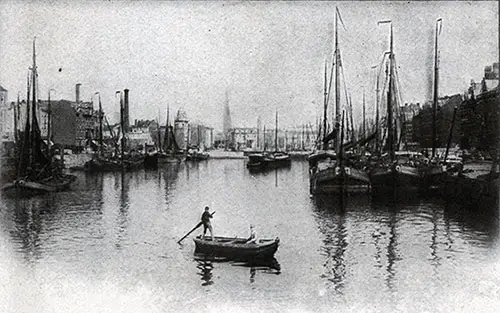
View of the Modern Seaport of Antwerp. | GGA Image ID # 11d9b330b7
Antwerp's commercial glory usually surprises and even dazzles visitors who are not prepared for it; though it is not at all discordant with the traditions of earlier centuries. In tonnage movements, according to the latest statistics, it is surpassed only by London and New York.
Still, one did not come to Antwerp looking for the latest wonders in contrivances in handling freight or coaling ships.
The antiquity of the city one did indeed expect to find, relics of the olden golden days, entertaining, marvelous objects of art and science, to see which the American with the national craving for acquired culture gladly leaves his home.
But this vision of a vast seaport, 45 miles from the ocean, with bustle and hustle along the whole length of its docks, with interconnecting basins and dry docks penetrating far inland.
With the ships of five continents represented in the vessels at the quays, the puffing and smoking of engines and the noises of the massive hydraulic cranes loading and unloading freight—all these things surprise us, while they attest that the Flanders of the twentieth has substantially retained the character of the Flanders of the sixteenth century.
Indeed, to one who wants to know old Antwerp—and it is a place to stay in for study rather than merely to make it a point of flight to other lands—the present-day aspects of the town can not be ignored. They enable one, in fact, the better to appreciate the antiquity, which is one of the city's most valuable assets.
THE COMMERCE OF THE CITY ...
For one thing, there are the quays and basins with their network of connecting railways, quite the most admirable system of terminal facilities on the continent of Europe. These make Antwerp one of the chief European entrepots of commerce.
The Scheldt here is from 900 to 2,000 feet wide, with a channel that has an average width of more than 1,000 feet and a mean depth of 30 feet at low water.
Along the left bank once stood the wharves which made Antwerp a significant market in the days of the Renaissance, but which have disappeared in the intervening centuries.
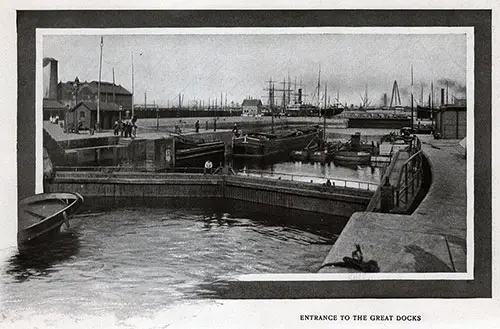
Entrance to the Great Docks at Antwerp. | GGA Image ID # 11d9bdae8c
None of the docks now in use is old, and very few of the warehouses that surmount them, though the Maison Hanseatique, built in 1564-8 by the celebrated Hanseatic League, still stands and does service.
Everything along the waterfront tends to correct any impressions the untraveled may have that only in American cities are the facilities for handling commerce well developed; Antwerp is fully abreast of the age.
The maritime basins in particular always prove attractive to the American of a practical turn of mind. They lie at the north end of the city and run far inland.
The oldest of them all, constructed by Napoleon during the years when he had it in mind to create at Antwerp a rival to the British commercial supremacy, is the Petit Bassin and the Grand Bassin.
In these, entered from the river by a narrow channel, several good-sized vessels can be moored for the discharge of cargo; but they early proved to be of insufficient size for the needs of the traffic of the port.
Later, therefore, another series or system of several interconnected basins was started. The entrance to these is through a moderately wide canal which runs up from the Scheldt into the great Bassin du Kattendyk.
Offshoots of this are the Bassin Mexico, the Bassin Aux Bois, the Bassin de la Carpine and the Bassin de Gatelage Nord, while at a little greater distance to the west of this system, and connected with it by the Bassin de Jonction, lie the Bassins Africain and Américain. There are also several dry docks.
REASONS FOR PROSPERITY
That its foreign and domestic commerce has been the making of Antwerp is not at all strange when one considers its geographical position, standing at the head of effective navigation on a tremendous tidal river.
Backed by the most thickly populated and industrious district of Europe, and possessed, furthermore, of communication by navigable waterways with almost every part of Holland and Belgium and even northern France.
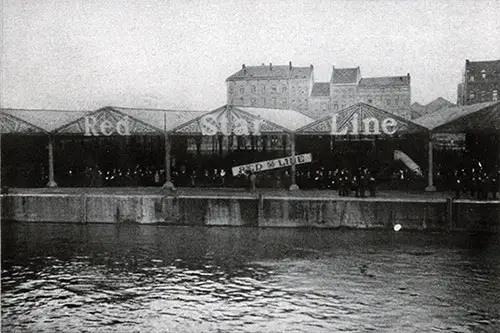
The Red Star Line Pier at Antwerp. | GGA Image ID # 11d9ef9ec8
It is also so situated as to be the most accessible and most natural Atlantic port for the entire German Empire, a shipping center upon which railway lines converge from every direction.
Besides, it must be conceded that in a general way the wellbeing of Antwerp has grown out of the prosperity of Belgium, which of late years has become a hive of industry.
Antwerp, as its only port accessible to vessels of large draught, would naturally be a great city even if outside influences, such as the incoming of the Red Star line, had not helped further to build it up and make it a port of entry to Europe.
One still sometimes hears it said by the unknowing that Antwerp has fallen from its high estate since the days when Charles V put off the crown of the Netherlands and the commercial prosperity of the port began to diminish.
As a fact, however, nothing is more precise than that the city has entirely recovered from the long centuries of stagnation; though it is possibly still time that the relative importance of Antwerp was somewhat more significant in the later Middle Ages than now, for in its most opulent period it was first, without a rival, among European cities.
DOCK SCENES ...
So many such present-day aspects of the town offer themselves that one could easily make a long book on every-day Antwerp. It is spectacular, picturesque, especially along the docks and quays, as we have already noted.
Here one observes the shipping of every clime from the Red Star liner of massive proportions down to the tiny boat of light enough draught to penetrate the shallowest canals of Holland.
All sorts and sizes of ships are here, some with livestock borne from American ports in the big cattle ships of the Red Star Line. Others, smaller and less imposing, bring sheep from England and Scotland across the turbulent North Sea.
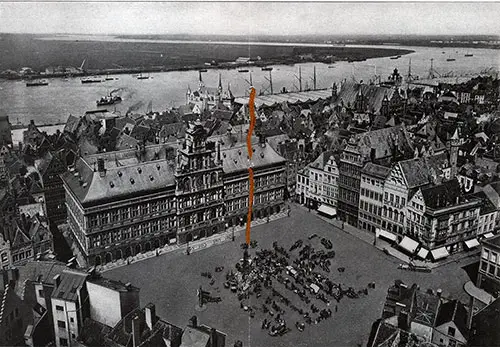
Panoramic View of the Port of Antwerp and the Red Star Line Docks. | GGA Image ID # 11da1e7c80
Most fascinating of all, and most like the pictures in childhood books, are the clumsy little Dutch canal boats, each one the home and abiding place of an entire family. Aboard one of these vessels sometimes one may note, besides man and wife, an aged grandsire, a couple of grandmothers and ten or a dozen children.
Heavily laden with grain or merchandise these boats often sink so low to the water’s edge that the visitor from another land fears to see them putting forth with their decks all awash.
Yet they rarely founder even in the roughest weather and, though their ends are as blunt as if sawed off, the Dutch sailor-folk handle them in the teeth of high winds in a positively marvelous manner, helped out by their large rudders and sturdy little sails.
If one goes aboard one of these peasant house-boats, one will discover that the cabins and living rooms are amazingly neat and convenient, as befits the habitation of a Netherlands family.
It is an amusing sight, furthermore, to stand on one of the low bridges about Antwerp and observe how, when a canal boat approaches, all hands rush to take a reef in the stovepipe and masts, which are jointed at the bottom so that they may be laid flat, sails and all.
As the canal boat slips under the bridge, frequently one of the urchins of the family will show his gymnastic ability by leaping up and catching hold of one of the bridge stringers, dropping back barely in time to avoid falling into the water.
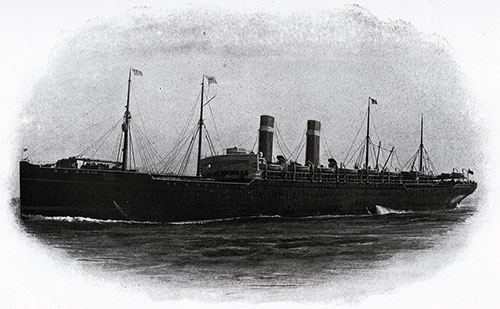
The Twin-Screw SS Vaderland, A New Type of Red Star Line Steamship. | GGA Image ID # 11da212ea0
ANTWERP AS A PORT FOR PASSENGERS. ...
BESIDES the advantages of the city of which we have spoken, Antwerp as a point of departure and embarkation offers facilities that have fully justified the policy of the Red Star Line in thus locating its European terminal.
As the gateway to Europe, it opens out with splendid railway service in every direction. To Paris, the distance is but 222 miles, with express trains leaving at convenient intervals.
The connections with the German Empire are well developed, and those who wish to visit picturesque Holland to the northward find both railroad and steamship service convenient and roomy.
To London and other cities of the United Kingdom, there is accessible transit by the Ostend, Harwich, Hook of Holland or Queensboro routes.
One feature of Antwerp as a seaport that makes it particularly agreeable is the ease of landing. At some European ports, passengers are put ashore by use of tenders or small boats, but at Antwerp, the steamships are moored alongside the company's piers, and you go directly to the street from the deck.
At only a short distance are the principal hotels and railway stations. The examination of baggage is briefer and less searching than in most ports since nothing, but tobacco and liquors, are subject to duty in Belgium.
Representatives of the steamship line meet incoming vessels at Flushing for the express purpose of giving passengers any information and assistance they need. Amongst the leading hotels of the city are the St. Antoine, Hotel de l'Europe, Grand and Hotel des Flandres.
EQUIPMENT OF THE RED STAR LINE...
The steamships of the Red Star Line are amongst those most favorably known to travelers. They do not belong to the class of ocean greyhounds but aim instead to exhibit qualities of steadiness, comfort, and reliability. Since the line was begun in 1871, it has carried more than 1,000.000 people without a serious accident.
The steamers now in the New York-Antwerp service are the following :
Finland, Kroonland, Vaderland, and Zeeland. These vessels are all admirable examples of modem naval architecture, specially constructed for the Atlantic service and built above the rigid requirements of the British Lloyds and the Bureau Veritas as well as the American laws. Their equipment of lifeboats and rafts is unusually complete.
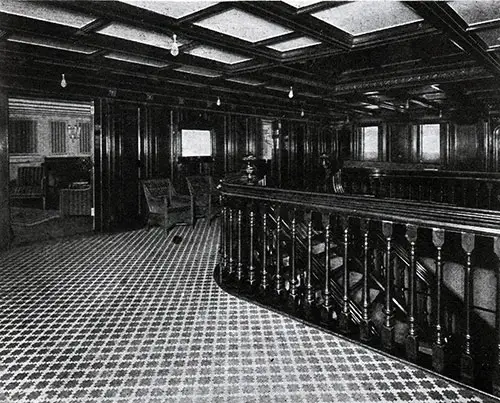
First Class Entrance Hall. Finland, Kroonland, Vaderland, and Zeeland. | GGA Image ID # 11da4bdf57
The twin-screw steamships Finland, Kroonland, Vaderland, and Zeeland, are the latest additions to the Red Star fleet. Of these, the Vaderland and Zeeland were built by Messrs. John Brown & Company, Ltd., Glasgow, and entered the service in 1901.
The Finland and Kroonland were built at the yards of William Cramp & Sons Ship and Engine Building Company, Philadelphia, and began their sailings in 1902. These four vessels are practically alike, their principal dimensions being: Tonnage, 12,760; length, 580 feet; breadth, 60 feet.
Amongst many advantages which they offer are the three beautiful decks, the promenade, upper and saloon deck, and the midship location of all first and second class saloons and staterooms in the part of the ship where the motion is slightest.
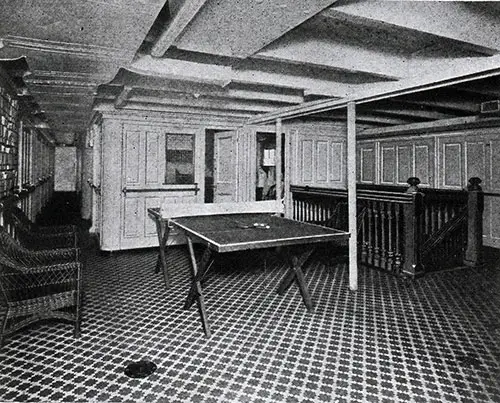
View of the Upper Deck Landing. Finland, Kroonland, Vaderland, and Zeeland. | GGA Image ID # 11da5547d7
The first-class dining saloon is spacious and handsome, extending the entire width of the vessel. Its lustrous white woodwork and furniture are of mahogany, excepting the sideboards, which are of handsomely inlaid satinwood.
On the promenade deck are found eight elegant deck rooms and four exclusive suites, each containing two rooms, with a lobby between them which communicates with private bathrooms and toilet rooms.
These rooms are so arranged that they can be used either as sitting-rooms or bedrooms. They are fitted with small folding tables and other conveniences, as well as extension beds.
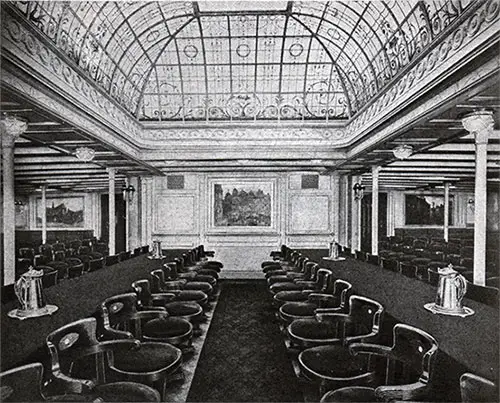
First Class Dining Saloon. Finland, Kroonland, Vaderland, and Zeeland. | GGA Image ID # 11da5693b9
Stateroom accommodations for 204 first-class passengers occupy a deckhouse on the deck next below the promenade deck, and on the saloon deck, there are accommodations for 106 first-class passengers.
These staterooms are all unusually large and the interior rooms which, in some vessels, are so dark as to need artificial light, are in these steamships lighted from overhead by oval glasses, corrugated in form and large enough to give ample light.
Electric lights are provided for extra illumination. All these rooms are finished in mahogany.
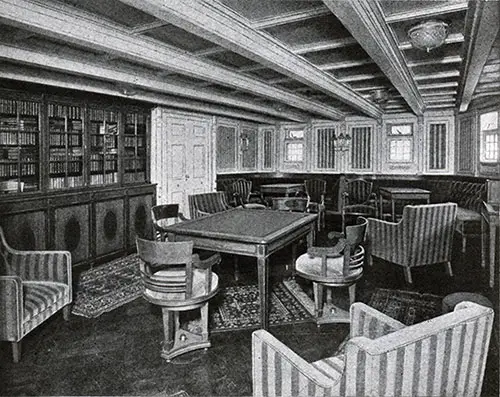
The First Class Library. Finland, Kroonland, Vaderland, and Zeeland. | GGA Image ID # 11da9a2b48
The music room and library are admirably located and tastefully adorned, being finished in white enamel with panels of striped silk upholstery. A handsomely designed piano and a bookcase, both in inlaid satinwood, and ample writing tables, are amongst the equipment.
The smoking room for first-class passengers stands on the promenade deck. It is paneled in fumed American oak, and the chairs and couches are upholstered in leather.
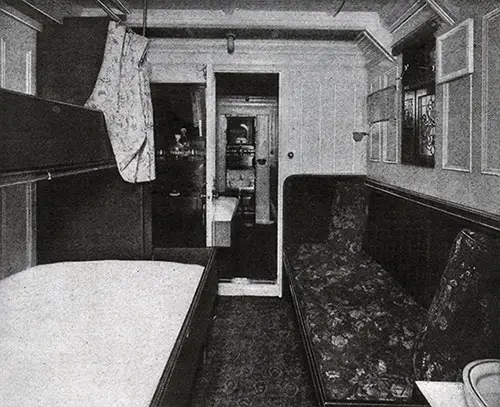
Promenade Deck Suites. Finland, Kroonland, Vaderland, and Zeeland. | GGA Image ID # 11dab9ea41
The second-class staterooms are fitted up almost in the same way as the first-class rooms and the saloon for the second class passengers is likewise a richly furnished apartment extending the entire width of the ship.
It is paneled in tapestry upon the soft cream-white ground, and the furniture is in mahogany.
At the after end of the promenade deck, which is set aside for second class passengers, stands the deckhouse in which is the entrance hall to the ladies' room, and abaft of this is the second class smoking room, exceptionally large and fitted with deep leather upholstered chairs, seats, tables for cards and every other convenience that smokers need.
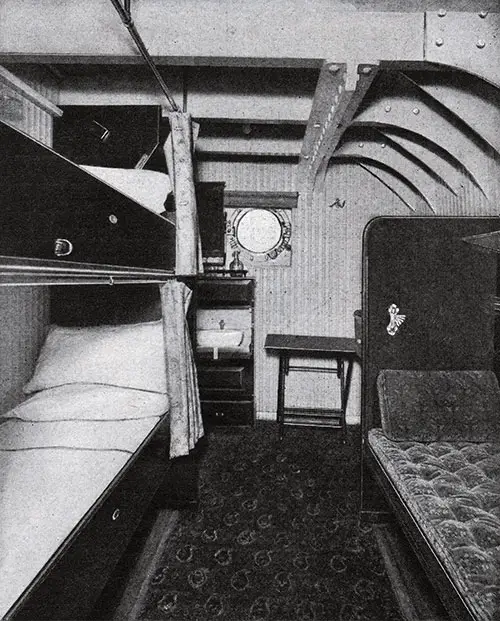
Upper Deck Stateroom. Finland, Kroonland, Vaderland, and Zeeland. | GGA Image ID # 11daf15fcf
The quarters of the third class are unusually spacious and well ventilated, with berths of the Hoskin's patent, having galvanized iron frames and woven wire springs.
Staterooms are containing two, four, and six berths for families. Well-lighted dining rooms with permanent tables covered with table cloths give the third class passengers good service.
They are waited upon by a sufficient number of stewards who likewise take care of eating utensils during the voyage. A stewardess looks after the welfare of mothers or girls who are traveling alone.
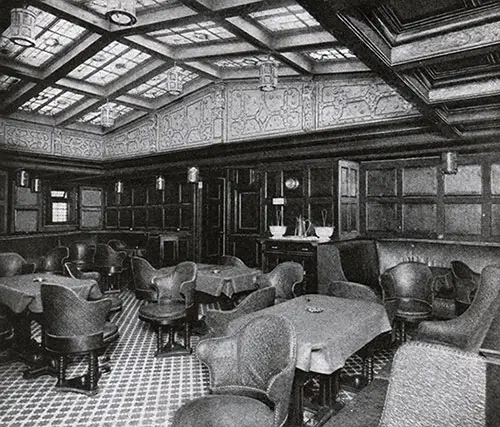
First Class Smoking Room. Finland, Kroonland, Vaderland, and Zeeland. | GGA Image ID # 11db614d11
The vital question of ventilation has received the utmost attention and employing the Sturtevant blowers, located on the boat deck, there is a steady but almost imperceptible breathing into the ship of the fresh air of the ocean, keeping them ever fresh and healthful.
In cold weather, the air is heated by passing over steam pipes, and the heat thus supplied may be regulated for each deck independently. By this superior arrangement, the inner rooms are made as comfortable as the outer ones.
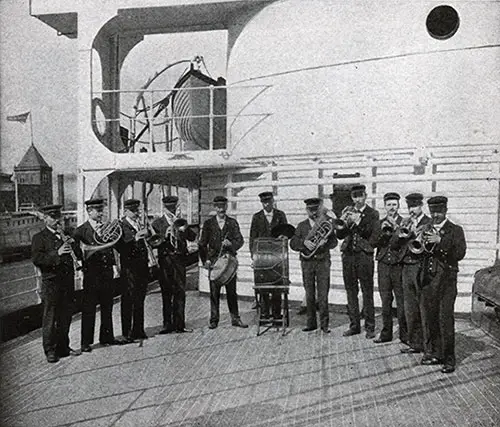
The Typical Ship's Band. Finland, Kroonland, Vaderland, and Zeeland. | GGA Image ID # 11db7e477e
This system also does away with the necessity of laying steam pipes in every room and ensures a comfortable temperature during all seasons of the year.
The four leading steamships of the Red Star service are equipped with the Marconi wireless telegraph system so that messages can be transmitted and received in connection with such permanent stations as the one on board the Nantucket South Shoals lightship, or with passing ships of other lines.
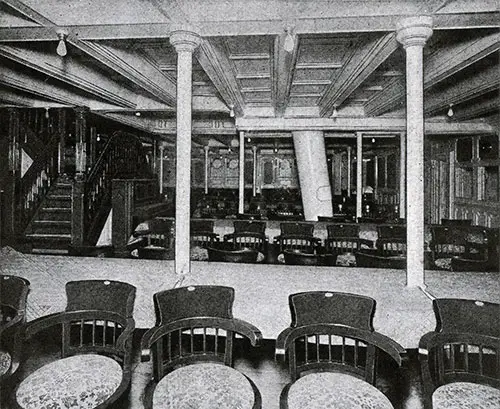
Second Class Dining Saloon. Finland, Kroonland, Vaderland, and Zeeland. | GGA Image ID # 11dbbc5fdb
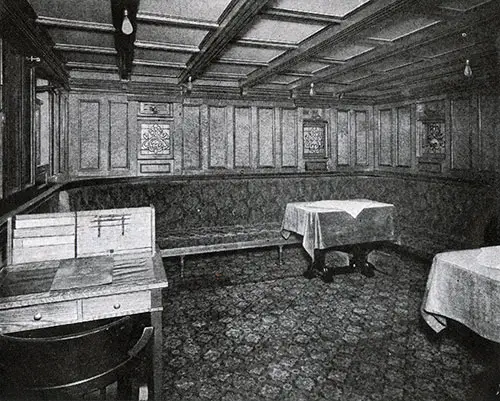
Second Class Ladies' Room. Finland, Kroonland, Vaderland, and Zeeland. | GGA Image ID # 11dbd04120
The service has already become much more than scientific curiosity; it often enables passengers to attend to important details of a business or to exchange greetings with near and dear ones.
Near the end of each voyage, the news items received from passing steamers and from the land stations, appear in the "Red Star News" printed on board and distributed freely amongst the passengers.
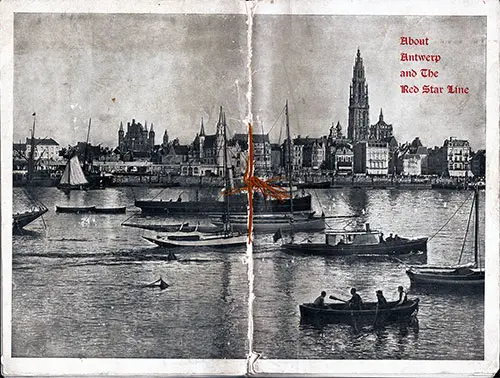
Full Cover of the 1904 Red Star Line Brochure About Antwerp. | GGA Image ID # 11dbdd01d5
Brochure Information
An Exquisite 1904 Brochure: About Antwerp and the Red Star Line
Description
A rare and richly detailed 1904 promotional brochure published by the Red Star Line, offering an extensive overview of Antwerp’s history, harbor, and the Red Star Line fleet. This 50-page booklet is a visual and textual celebration of the city’s cultural and commercial significance, enhanced by evocative descriptions of Antwerp’s approach via the Scheldt River and its bustling maritime activities. The brochure features numerous high-quality photographs, including images of Antwerp’s harbor, the Red Star Line piers, and the twin-screw steamships Finland, Kroonland, Vaderland, and Zeeland.
Dimensions: 25.5 cm x 19 cm
Pages: 50 (inclusive of covers)
Language: English
Visual Content: Includes 30+ photographs and illustrations of Antwerp, Red Star Line vessels, and passenger accommodations.
Key Features
- Comprehensive Overview: Detailed descriptions of Antwerp’s maritime importance, modern seaport infrastructure, and historical charm.
- Red Star Line Fleet: Features the line’s premier vessels, highlighting their technical innovations, luxury accommodations, and transatlantic service.
- Photographic Treasures: Stunning images of Antwerp’s docks, canal boats, Red Star Line steamships, and onboard facilities, offering a glimpse into early 20th-century ocean travel.
- Historical Context: Insightful commentary on Antwerp’s resurgence as a key European port and the role of the Red Star Line in its prosperity.
- Innovative Maritime Features: Descriptions of ship amenities, including advanced ventilation systems, elegant staterooms, and the Marconi wireless telegraph system, which marked a leap in passenger communication.
Provenance
From a distinguished private collection of maritime memorabilia, this piece has been preserved in exceptional condition. It is a testament to the era’s craftsmanship and dedication to promoting the Red Star Line’s services.
Condition
- Cover: Clean and intact, with minor wear to edges consistent with age. The imagery retains vibrant clarity.
- Interior Pages: Bright, clean, and unmarred, with crisp photographic reproductions and legible text.
- Binding: Secure and intact, ensuring the brochure’s longevity.
Historical Significance
This brochure is a testament to Antwerp’s emergence as a key European port at the turn of the 20th century and the Red Star Line’s influence on transatlantic travel. It highlights the luxurious yet practical advancements in passenger shipping during a time when ocean liners were the pinnacle of innovation and connectivity. The brochure also reflects the growing interest in European travel among American audiences, making it a significant cultural artifact.
Final Conclusion
This 1904 Red Star Line brochure is a rare gem that combines historical depth, aesthetic appeal, and maritime innovation. Its pristine condition, comprehensive content, and evocative imagery make it an extraordinary artifact for collectors and historians alike.
